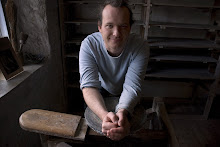
We in the west came later to discover it, but our obsession with it is no less strong. It is one of those materials that still resonates with a certain 'je ne sais quoi' to use an english expression.
Once only fit for the imperial household, royalty or nobility, it is now been 'democratised' and is such a common material of our daily lives.
Man has conceptualised it, homoginised it, defloculated it and slip casted it.
The most tempermental of ceramic materials has been tamed by industry, but even with all those pressure vacum schaking devices it still manages to sometimes have a mind of its own. It has memory, and like picking up a stray cat- one must be vigilant, or it will strike back at you with a vengence!
For me this is how it all started-
One day I discovered a book of Korean 12 centruy Chosun Ceramics and fell in love, and this coinscided with my discovery of chinese tea.
A voice resonated in my head.
Why are these wonderfully sensusly etherial pieces only in books and museums?
why are they only reserved for emperors or rich art collectors?
As tea drinkers why do we settle for those beautifully fine but DEAD industrial porcelain cups?
My zelus naivety had thrown me on a very rocky path wich at times has been quite funny.
I spent the last five years trying to make fine porcelain pieces fit for drinking fine tea.
As a sculptor I tryed modeling a fine cup then casting it and pressing pocelain into the mould, which took ages and would finally crack.
Then after reading about how Chinese pocelains were never always 100% porcelainous, I made mixes of white stoneware with porcelain. The results were not satisfactory.
So I continued to press white stoneware into moulds and then spent so `much time recarving, and remodeling the cup.
I ended up with about the equivalent of one cup per day, often still distorted and too heavy for the finest tea.
I convinced myself that these early cups were going to get better.
But after 3 years the feed back about my work was, "your work is very heavy'.
How can I get even near to industrial lightness and fineness?
I swallowed my pride went back to the begining, and learnt to throw.
I worked at the Leach pottery to sharpen up this new skill and discoverd so much more in the process.
The magic of porcelain and stoneware- the wonder of reduction glazing and firing.
That's why I want to share with you my way of preparing and making a porcelain cup. 
Cela fait Cinq ans qu'a commencé ma quete pour la fabrication de coupelles en porcelaine.
Ce chemin à été bien rocailleux, parfois meme tragi-comique.
Mes premieres pieces étaient plus proche de la sculpture que de la poterie.
Après 3 années j'ai du ouvrir mes yeux à l'évidence que mon travai était trop lourd et pas assez fin pour qu'on puisse y boire les thés les plus fins.
Je me suis donc mis a apprendre le tour.
Puis j'ai fait mes armes à la Leach Pottery.
Comme tout Quete digne de ce non je n'en revient pas.. Tout ce que j'ai eu l'occasion de découvrir.
Mi artistique -mi alchimie la poterie pour la voie du thé me fascine,
m'envoute.. même si ces cinq dernieres années ont été les années des plus dures.
Enfin ... je vais vous faire partager ma façon de preparer la porcelain pour en faire des coupelles à Thé. 
La méthode en 'spirale', une fois la terre pré-préparé est beaucoup plus homogène. On dirait un coquillage. 
Ram's horn wedge- top left image
Shell like Spiral wedge- last image
The Quest for 'White Gold'- à la Recheche de 'l'Or Blanc'
Inscription à :
Publier les commentaires (Atom)

6 commentaires:
La première photo est superbe. Quelle beauté et quelle pureté dans cette tasse !
Vivement la suite.
++
Bonjour Michel,
It's epure pour "l'épuré..."
épure (n.f.)
1.dessin à grande échelle qui aide pour la construction d'un édifice, le montage d'une machine.
2.dessin linéaire représentant une figure à trois dimensions.
3.(figuré)grands traits d'un projet.
épurer (v.)
1.rendre pur, plus pur.
2.(figuré)exclure d'un groupe les individus indésirables.
Cela correspond comme un collé au coté très épuré de ta first white gold.PORCELAINE;
à suivre donc.
MERCI.
.PHILIPPE.
les photos en noir/blanc collent au propos ... cette quête est....si attirante et si dense et si exigente , parsemée de mille embûches . Il est bon aussi de partager et d'être porté par des regards connaisseurs, bon critiques, exigents et bienveillants, par des amis aussi.merci pour ton partage ici
Enregistrer un commentaire